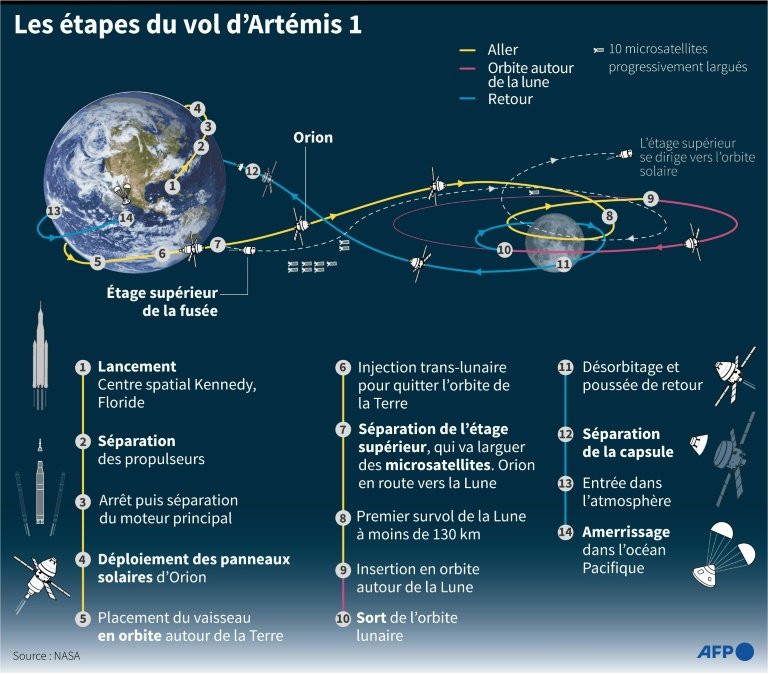Returning to Earth from the Orion spacecraft, the Artemis 1 lunar mission has concluded successfully
France Press agency , Posted on Monday, December 12, 2022, at 08:42
After spending just over 25 days in space and orbiting the moon, NASA’s Orion spacecraft touched down in the Pacific Ocean on Sunday, the final stop on a successful mission that heralds the return of humans to the moon in the years to come.
The landing took place off the Mexican island of Guadalupe at 5:40 pm GMT (9:40 am local time).
“I don’t think any of us could have imagined a more successful mission,” Mike Sarafin, NASA’s Artemis 1 mission commander, said in a news conference.
The capsule, which did not have an astronaut on board for this test flight, entered the earth’s atmosphere at a speed of 40 thousand km / h, and it had to endure an infernal heat of 2800 degrees Celsius, which is half the temperature of the surface of the sun.
The ship was slowed in its revolving descent by a chain of no fewer than eleven parachutes, until it reached a speed of about 30 km/h when it hit the water.
“We had an absolutely perfect landing,” said Melissa Jones, recovery operations officer, who NASA has been training for years.
Soon after, helicopters hovered over the spacecraft, with no visible damage visible. Orion was left in the water for several hours — much longer than if the astronauts were on board — in particular to monitor the heat induced inside the capsule.
Divers then attached cables to it in order to tow it using inflatable boats into the interior of a US Navy ship, the USS Portland, whose stern was partially submerged. Then the water had to be pumped out, allowing the capsule to slowly settle onto a support provided for the purpose.
Operations were expected to take between four and six hours in total.
Then, the USS Portland will make its way to San Diego, on the US West Coast, where it will drop the capsule in the coming days.
– 2.2 million km –
The success of this mission was crucial for NASA, which has invested tens of billions of dollars in the American program to return to the moon, Artemis. After returning humans to the lunar surface, his goal was to prepare for a future trip to Mars.
The main objective of this first mission was to test the resistance of the capsule’s heat shield, the largest ever (5 meters in diameter).
In 2014, the first test was carried out, but after that the capsule did not leave Earth’s orbit, and therefore entered the atmosphere at a slower rate (about 32,000 km / h).
In total, this time the spacecraft has traveled more than 2.2 million kilometers in space since it took off on November 16 during the first flight of NASA’s new massive SLS rocket.
Orion flew past the moon just 130 kilometers from its surface, and ventured more than 430,000 kilometers from our planet, farther than any previously habitable spacecraft.
– Artemis 2 and 3 –
The recovery of the capsule will allow the collection of much crucial data for future missions, particularly that of the acceleration and vibration sensors on board. Some elements of the ship should also be reused for the Artemis 2 capsule, which is already well developed.
This second mission, scheduled for 2024, will take a crew to the Moon, without landing there. NASA is expected to announce the names of the astronauts selected in early 2023.
Artemis 3, officially scheduled for 2025, will land for the first time on the south pole of the Moon, where there is water in the form of ice. After that, NASA would like to launch one mission each year.
“We have equipment under construction all over the world even for Artemis 5,” NASA associate administrator Jim Frye said Sunday.
Only twelve men, all white, set foot on the Moon thanks to the Apollo missions – for the last time in 1972, fifty years ago to today.
This time the Artemis program should send its first woman and first person of color there.
NASA’s goal is to establish a permanent human presence on the Moon, with a base on its surface and an orbiting space station. Learning to live on the Moon should test all the technologies needed for a trip to Mars – possibly in the late 2000s.

“Incurable web evangelist. Hipster-friendly gamer. Award-winning entrepreneur. Falls down a lot.”

